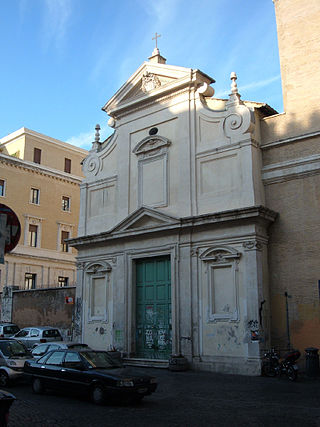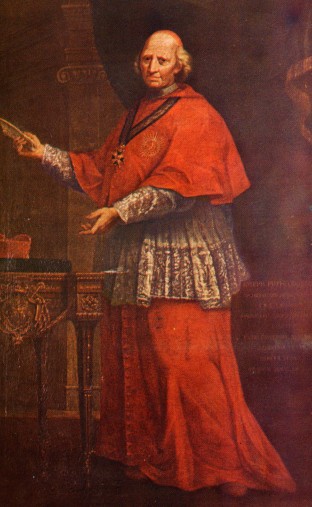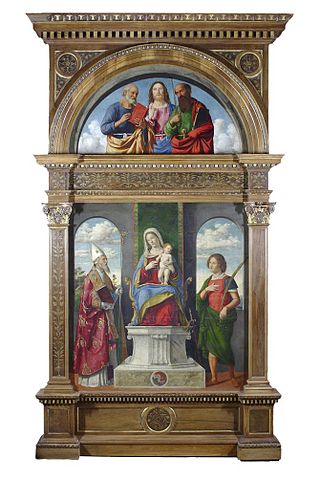Gallery
- Saint Joseph with Child, after 1730 - before 1783
Vittoria Ligari | |
|---|---|
| Born | February 14, 1713 |
| Died | October 9, 1783 (aged 70) |
| Nationality | Italian |
| Known for | Painting |
| Style | Christian art |
Vittoria Ligari (14 February 1713 - 9 October 1783) was an Italian painter.
Vittoria Ligari was born in Milan, near San Babila, in February 1713. Her mother was Nunziata Steiningher and her father was Pietro Ligari. [1] She died in December 1783. [2]

Vittoria Colonna, marchioness of Pescara, was an Italian noblewoman and poet. As an educated, married noblewoman whose husband was in captivity, Colonna was able to develop relationships within the intellectual circles of Ischia and Naples. Her early poetry began to attract attention in the late 1510s and she ultimately became one of the most popular poets of 16th-century Italy. Upon the early death of her husband, she took refuge at a convent in Rome. She remained a laywoman but experienced a strong spiritual renewal and remained devoutly religious for the rest of her life. Colonna is also known to have been a muse to Michelangelo Buonarroti, himself a poet.

The Biblioteca Ambrosiana is a historic library in Milan, Italy, also housing the Pinacoteca Ambrosiana, the Ambrosian art gallery. Named after Ambrose, the patron saint of Milan, it was founded in 1609 by Cardinal Federico Borromeo, whose agents scoured Western Europe and even Greece and Syria for books and manuscripts. Some major acquisitions of complete libraries were the manuscripts of the Benedictine monastery of Bobbio (1606) and the library of the Paduan Vincenzo Pinelli, whose more than 800 manuscripts filled 70 cases when they were sent to Milan and included the famous Iliad, the Ilias Picta.

Giovanni Ambrogio Figino was an Italian Renaissance painter from Milan.

Sebastiano Ricci was an Italian painter of the late Baroque school of Venice. About the same age as Piazzetta, and an elder contemporary of Tiepolo, he represents a late version of the vigorous and luminous Cortonesque style of grand manner fresco painting.

Giuseppe Antonio Petrini was a painter of the late-Baroque, active mainly in Lugano, present-day Switzerland.

Giovanni Pietro Ligario (1686–1748) was an Italian painter and architect of the late-Baroque.

San Callisto is a Roman Catholic titular church in Rome, Italy, built over the site of Pope Callixtus I's martyrdom.

Vittoria TesiTramontini, also known as "La Fiorentina" or "La Moretta" was an Italian opera singer of the 18th century. Her vocal range was that of a contralto. She is "regarded as the first eminent singer of color in the history of Western music".

The Apostolic Vicariate of Tripoli is a Latin Church missionary territory or apostolic vicariate of the Catholic Church in Tripolitania, Libya.

Giuseppe II Pozzobonelli was an Italian Cardinal and the Archbishop of Milan from 1743 to 1783.
La passione di Gesù Cristo is a libretto by Pietro Metastasio which was repeatedly set as an azione sacra or oratorio by many composers of the late baroque, Rococo and early classical period.

In music history, the Neapolitan School is a group, associated with opera, of 17th and 18th-century composers who studied or worked in Naples, Italy, the best known of whom is Alessandro Scarlatti, with whom "modern opera begins". Francesco Provenzale is generally considered the school's founder. Others significant composers of this school are Giambattista Pergolesi, Domenico Cimarosa and Giovanni Paisiello.
It is with the Neapolitan school...that the History of Modern Music commences—insofar as that music speaks the language of the feelings, emotions, and passions.

Giovanni Battista Sassi was an Italian painter, active mainly in Milan and other areas of Lombardy, who painted in a late-Baroque and Rococo style.

Giuseppe Oriolo or Orioli was an Italian painter of the late-Baroque.

Sebastiano Biancardi, known by the pseudonym Domenico Lalli, was an Italian poet and librettist. Amongst the many libretti he produced, largely for the opera houses of Venice, were those for Vivaldi's Ottone in villa and Alessandro Scarlatti's Tigrane. A member of the Accademia degli Arcadi, he also wrote under his arcadian name "Ortanio". Lalli was born and raised in Naples as the adopted son of Fulvio Caracciolo but fled the city after being implicated in a bank fraud. After two years wandering about Italy in the company of Emanuele d'Astorga, he settled in Venice in 1710 and worked as the "house poet" of the Grimani family's theatres for the rest of his career. In addition to his stage works, Lalli published several volumes of poetry and a collection of biographies of the kings of Naples. He died in Venice at the age of 62.

The Church of Santa Sofia is a Roman Catholic church in the city of Lendinara, in the Province of Rovigo, region of Veneto, Italy.

Madonna and Child with Saint George is an oil on panel painting by Correggio dating to around 1530 and now in the Gemäldegalerie in Dresden.

The Pinacoteca Civica di Palazzo Volpi is the town art gallery on Via Diaz 84 in the town of Como, Lombardy, Italy. It is housed in the 17th-century Palazzo Volpi.

Madonna and Child Enthroned with Two Male Saints is a 1489 oil-on-panel painting by the Italian Renaissance painter Cima da Conegliano, previously owned by the church of San Dionisio in the Zermen district of Feltre and now in the Museo Civico in that town.